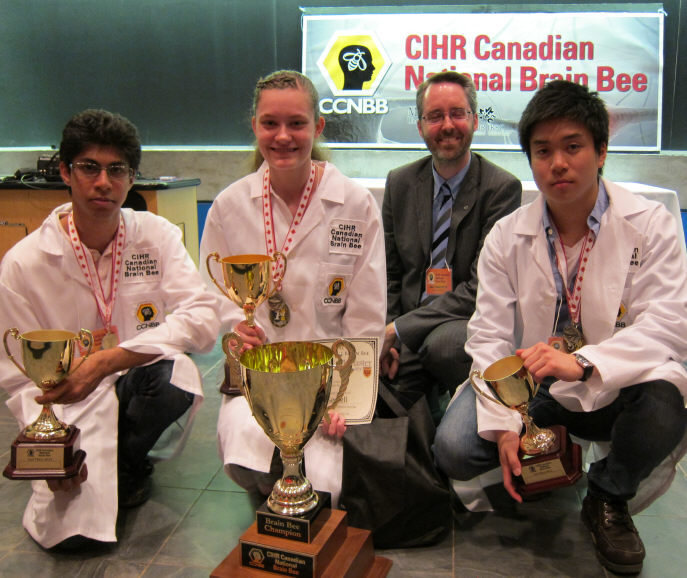Fifth Annual Competition, May 26, McMaster University
Find more photos here: 2012 CCNBB Flickr Photos
On May 26th the top high school students from across Canada came to McMaster University to compete for the right to be called the best brain in Canada. These are the students who won their regional competitions and the right to be called the best brain in their regions. They studied hard to prepare for challenging events that tested their knowledge of neuroscience and their skills at patient diagnosis and neuroanatomy.
The competitors represented regions across Canada, from East to West:
Greg Penney, representing Newfoundland Brain Bee
Amrit Sampalli, representing Halifax Brain Bee
Laura D’Aronco, representing Montreal Brain Bee
Adil Abdulla, representing Ottawa Brain Bee
David Kim, representing Toronto Brain Bee
Toluwanimi Odemuyiwa, representing Guelph Brain Bee
Jessica Johns, representing Waterloo Brain Bee
Manjot Sangha, representing Hamilton Brain Bee
William Klanac, representing London Brain Bee
Sandy Xu, representing Edmonton Brain Bee
Shine Vazhappilly, representing Calgary Brain Bee
Laronna Sewell, representing Vancouver Brain Bee
Eugene Tang, representing Victoria Brain Bee
All of the competitors were amazing and did extremely well. But there can be only one in first place.
The winners in 2012 are:
First Place and 2011 CCNBB Champion: Laronna Sewell representing Vancouver Brain Bee
Second Place: Adil Abdulla representing Ottawa Brain Bee
Third Place: David Kim representing Toronto Brain Bee
 1st, 2nd, and 3rd place winners won trophies and cash prizes. Laronna also won a travelling trophy to display at her high school for one year, and the opportunity to work as a summer intern in a neuroscience laboratory. The challenge is not over for Laronna — she will represent Canada at the International Brain Bee (IBB), July 22-27 2012 in Cape Town, South Africa.
1st, 2nd, and 3rd place winners won trophies and cash prizes. Laronna also won a travelling trophy to display at her high school for one year, and the opportunity to work as a summer intern in a neuroscience laboratory. The challenge is not over for Laronna — she will represent Canada at the International Brain Bee (IBB), July 22-27 2012 in Cape Town, South Africa.
It was a long day with many tough challenges. The morning started out with a hearty hot breakfast buffet, and then a multiple choice exam. From there, a walk to the neuroanatomy labs of the Education Program in Anatomy where they were challenged with the same (very difficult) bell-ringer exam (real human brains) that is given to the medical students at McMaster (thank you Dr. Laurie Doering for offering this excellent experience). That was followed by the Patient Diagnosis exam in the Centre for Simulated Learning where the medical students train. It is set up with realmedical offices and real equipment and offers the Standardized Patient Program with professional standardized patients (SPs) trained to reproduce a patient with a brain disorder or disease. The students interviewed and diagnosed nine different SPs. Finally, after 3.5 hours of morning tests, it is lunch time.
After lunch we launched into the afternoon challenges. First, 20 questions in multiple choice format in the lecture hall where the students performed in front of parents and teachers (holding up A, B, C, and D cards to indicate their answers for all to see). At this point, all the scores from all the tests so far were added up, and the top 3 competitors advanced to the final rounds of oral questions. The first set of questions was set up similar to Final Jeopardy; a question was read aloud and the students had only a few seconds to write down their answer and hold it up to the audience. It was so close! The third place winner was only 1 point away from the other two. The second set of questions required spoken answers, again only a few seconds within which to respond. Another very close competition! 1st and 2nd place were only 2 points apart!
Congratulations everyone in 2012.

